The First Volley scenario from @GMTGames Vietnam, focusses once more on I Corps action. With Marine units recently landed and the VC and NVA looking to show the USMC who is the boss.
Its just a two turn scenario but as we know there are a lot of moving parts for these things, so it will take a bit of time to get through.
Before starting I have had experimenting with conducting Security Ops in the Strategic movement phase with the Marines to ‘upset’ or disrupt planned VC activity, or knock patrol units out of or off key roads. The problem with that approach is it uses up your best units for the turn and sucks down the available air factors for Ops when you eventually do get to activate.
So for this first turn, NLF elected to take the 1st Op, and activated 2 units. Then we experimented and changed that to three units being used for the op.
VC elements advance up to Qang Ngai. In doing so they also capture Durc Pho.
There are a number of ways you can run your operations.
We could in this case select between 1 and 4 units to operating in the upcoming Search and Destroy VC operation [ those with in effective movement range].
Lets see how that might pan out using 2 units and then three units.
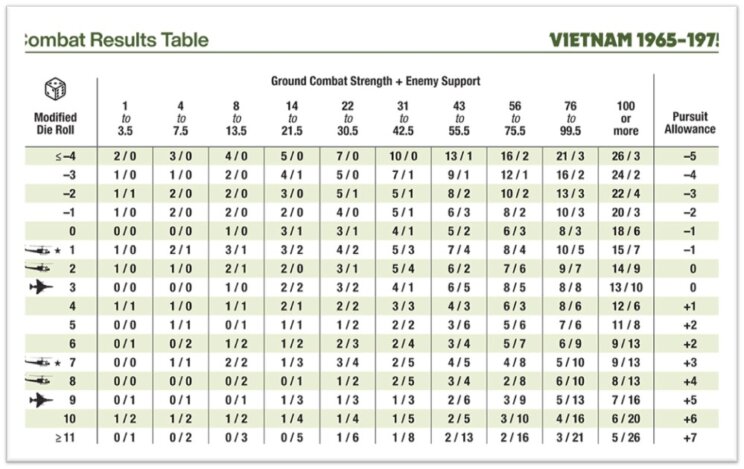
With two units we would have 4 combat factors vs the one in Qang Hgai. The US allocate air when the NLF have a phase for an Operation, they allocated two air of their ten available for the turn to ground support for the VC Operation.
The amount you allocate matters as those that are familiar with the CRT, know that the enemies losses are a function of the combined attacking combat factors and the defending ground support for the attacker and the defenders losses are their combat factors plus the enemies ground support.
When we look at the CRT and understand that VC are going to be attacking we as the Allies want to push their combat results up across the ten columns on the CRT to the right, while keeping ours as low as possible. There are also 16 row results from -4 to greater than 11, theses die roll modifiers are terrain and odds based for the most part. On the lowest of the columns 1-3.5 combat factors there are 8 results that do not cause an attacker loss, just 6 on the 4-7.5 column and 4 then 2 finally in the 14-21.5 combat factor column. Maximising the number of replacements lost or steps killed while the VC attack means less we have to kill later.
So with a VC attack consisting of two units [4 CF no arty] it’s a straight 4:1 attack against the ARVN Battalion stationed there. If there was no US air allocated the attack would generate a +4 DRM to the attacker and a -1 for terrain for the defender. For a net plus 3. Not great for either side really.
However we have the Air Support that boosts the defense to 3. Dropping the odds from 4:1 to 4 vs 3 or 1:1, with a -1 DRM for terrain. Better for the ARVN.
[Note in these combats I do not use the RF [Regional Forces] values. Most towns and cities have 2 RF which would bump the number defence factors and raise the losses able to be taken before elimination.]
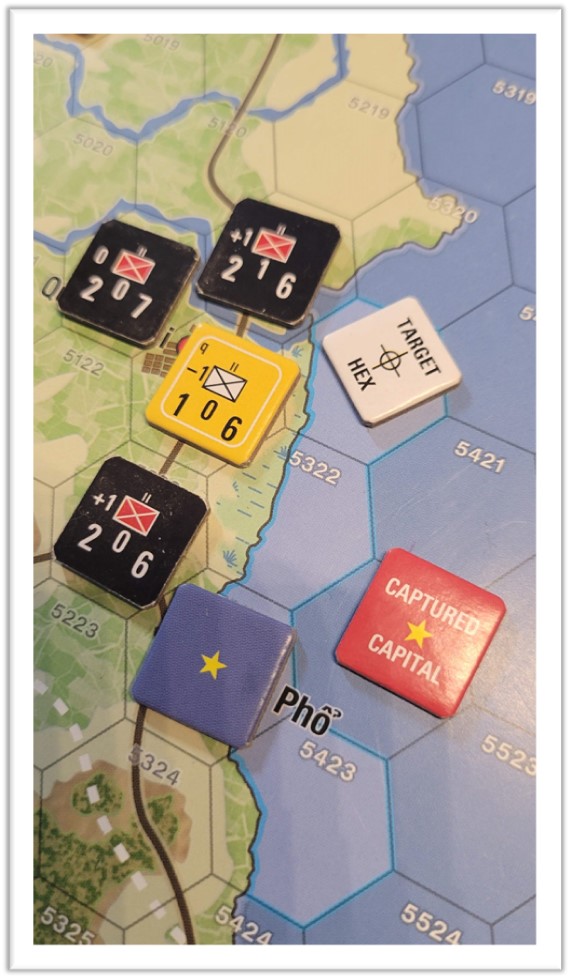
Assuming we roll a 3 we now lookup the result. 4 attacker factors plus 2 enemy support means we resolve on the 4-7.5 column the 1d6 roll of three drops to 2 for the TEC DRM.
Yielding a 1/0 result.
The VC lose 1 step. Looking at the 1 to 3.5 column the ARVN also yield a 1/0, meaning no loss for them. There are no pursuit allowances [far right column].
What happens if three units attack. 7 [ plus 1 organic Art] factors vs 1 [+2 air support] is a 2:1 with a net +1 DRM [-1 terrain +2 for odds].
With a 1d6 roll of three rising to 4 lets see the result that generates.
Attacker: 6 factors + 2 for Allied air = 8. They shift up one column and the four result is a 1/1, Attacker loses 1 step.
Defender: The ARVN are 1 CF +1 for enemy arty, so they stay in the leftmost column and on a four earn a 1/1. Losing a step.
The defender was unlucky here as only 6 of the 16 results allow for a defender loss on the left most column. A roll of 1,2,4 or 6 would have meant no loss for the defense.
Net result is one step lost for each side. In both cases both sides can lose replacement points to cover losses.
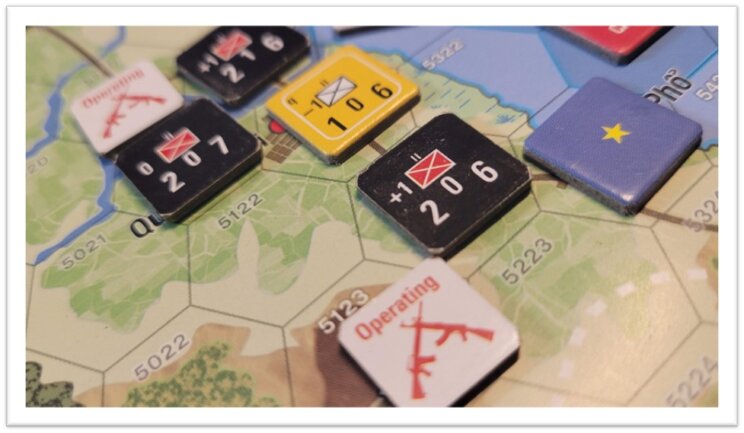
What does it all mean? Obviously the “right amount” of air allocated or arty allocated to an operation both on the defense and offense can move results. As you will see in larger combat factor fights, say 31 factors, the swing is 10 down to 1 loss for the attacker m and 0 up to 8 for the defender. Moving the needle in larger battles is much, much harder.
Both sides in their own way will benefit from a death by a thousand cuts approach vs ‘decisive’ engagement strategies. Imagine generating a 4:1 attack on a NVA units with a defense of 7. You have 28 factors to generate your 4:1. In order to move them up one column, its easy enough, but two would require 6 plus support factors, or 14 for three columns. However the consequences of a 28 factor attack on the NVA who have 2 or more supporting arty would push the Allies into the 31-42.5 loss column guaranteed to lose at least two steps. With a 28 combat factor attack and no support the NVA have 1 chance to lose zero steps and 3 chances equally to lose 1 or 2 steps [assuming a plus 4 on a 1d6 roll] With air and arty shifts a minimum of 7 support factors is required to guarantee at least 1 loss and as many as 5.
Scaling up attacks feels very risky unless enabled by supporting forces and enough DRM’s to lock in losses.
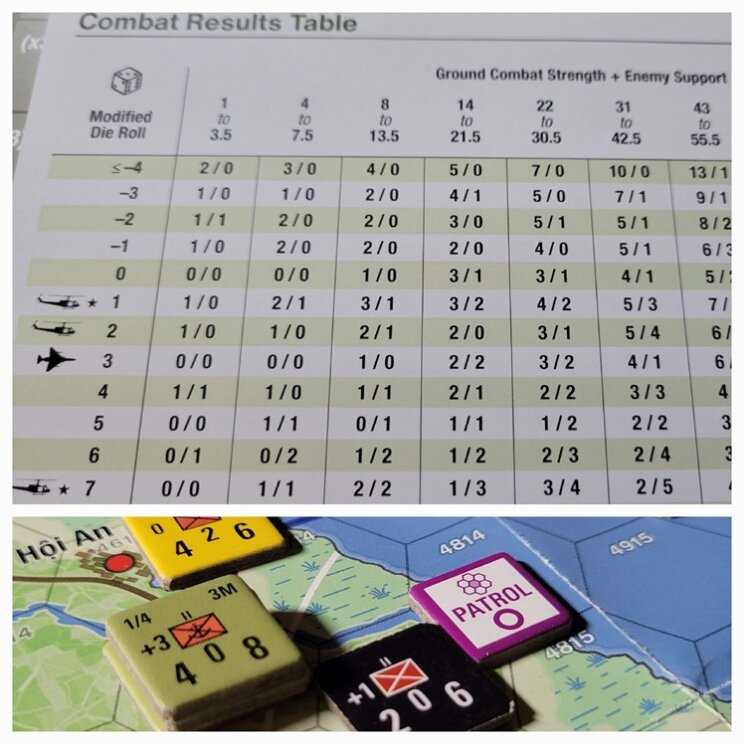
Given some available time and bandwidth for thought, we will next look at Retreat & Pursuit, as well as Reserves.
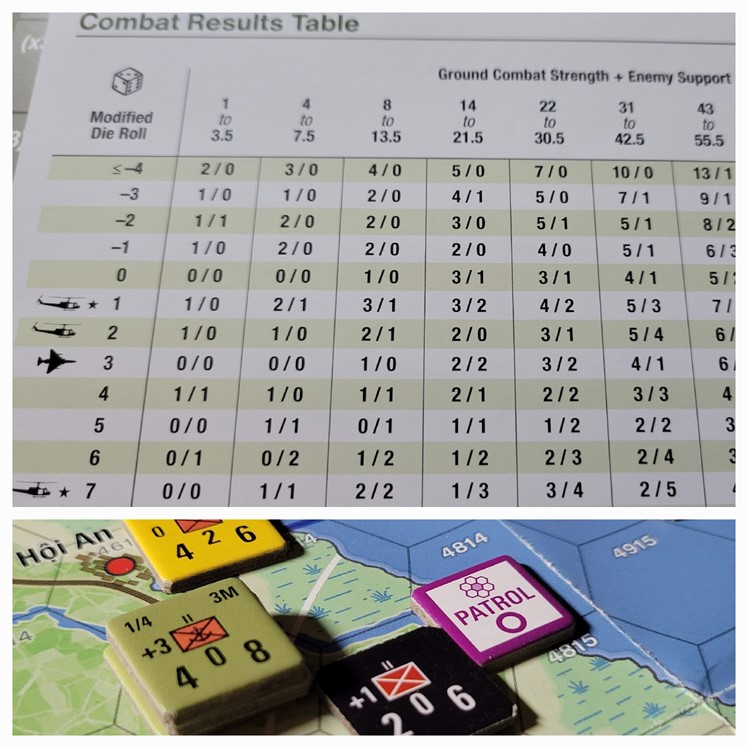
Important observations as ever. If one is understanding your commentary correctly, the CRT seems to reflect the warp of the war, with the US and its allies pushing for the decisive battle, but in doing so running the risk of higher casualties which would then make it difficult to continue waging the conflict. Each side is attempting to fight a war different from the other, struggling to turn the terms of violent trade towards its own preferred military doctrine. Very interesting indeed.
You put it much more succinctly than I did ! Yes. That would be the essence. The other factor emerging as I now do several of these low grade VC focussed attacks on ARVN and US forces is the fruitless nature of them. It however is out of context with the campaign. I suspect the ‘full’ appreciation only arises with campaign play.